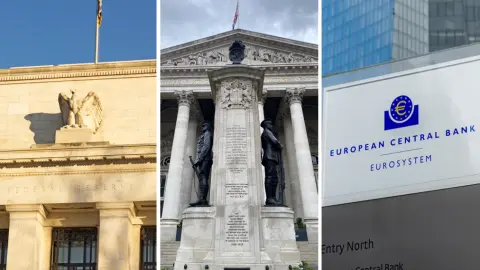Term and Repo in vogue in US money markets
Invested volumes are impressive and expected to stay that way. The rising trend in Bills over Repo may subside should a debt ceiling saga really kick off. There is more term now than before, and while not overly generous offers value on the expectation that the Fed cuts rates later in 2025. QT is set to end by mid-year, and RRP usage to only spike at turns
Money market funds remain a valid investment choice, even if the Fed cuts some more
Money market funds have seen a seemingly relentless rise in assets under management in the past five or six years. The first phase of this occurred during the first year or so of the pandemic, bolstered by corporates beefing up cash buffers. On some measures, the proportion of institutional money market funds held by corporates rose from sub-40% to more than 60%. It has since settled in the 50-60% area. The second phase coincided with the Fed’s rate hike cycle, as absolute rates rose. And as money market exposure is 'price risk-free', it has offered an attractive foil to bond or risk asset alternatives. Even with the Fed cutting rates, absolute rates in the 4.25%+ area remain attractive.
For 2025, there will be a tolerance for a few more cuts from the Fed before players begin to question the absolute levels attainable. A 4%+ handle remains very attractive. A break below 4% would not necessarily cause severe liquidation. We suspect such conversations will begin if the Fed gets below 3%, as we see the 3% area as a neutral valuation for the funds rate (so rates below that should be viewed as sub-optimal). That said, corporates have evolved into large holders of money market funds, and such holdings are liable to prove quite sticky. We'll see the US$7tr area held for the foreseeable, as the Fed is unlikely to get anywhere near the 3% area.
Money market fund holdings outright, and as a proportion of GDP

As a percentage of the value of GDP, money market fund holdings were even higher before the Great Financial Crisis. Several regulatory changes since then saw holdings fall from a high of 27% of GDP in 2008 to a low of sub-14% of GDP some 10 years later. Then the pandemic hit. And now money market funds are back up to a little over 23% of GDP. Looking ahead, it is more likely that money market funds trend in line with GDP, rather than faster than GDP.
Breakout of funds by investor type and product shows some stark individual movements
Institutional players have edged their Prime Fund holding lower post-recent rule changes. But this has been offset by ongoing significant rises in money market investment by retail players. Additional institutional cash is predominantly biased toward Government Funds where liquidity requirements are higher and "gates and fees" are less of an issue (compared to Prime funds).
Institutional cash still biased to Government Funds, while retail growth is in Prime Funds

In terms of portfolio breakdown, Government Funds are seeing an ongoing rise in holdings of Treasury Debt (effectively bills). In the wider market setting, Bills now represent some 22% of overall government debt financing, up from the 15% area in 2022/23, implying that extra Bills issuance is being employed to take pressure off coupon issuance.
Exposure to Repo is steadier now in Government Funds, but still well down from the highs seen in 2023. The preferred value play here has been in Bills. For now, the high net Bills issuance environment remains in play. However, as we get deeper into debt ceiling control measures there will be more pressure to reduce net Bills issuance, which can add a premium to prices. That can result in more cash moving back into Repo.
In Prime Funds, Repo (reflecting equity repo) exposures remain on the increase, as is exposure to commercial paper (CP), while certificates of deposit (CD) and ordinary deposits have been steadier to a tad lower. This is in part correlated to the quantitative tightening (QT) process.
Big moves in holdings of Repo vs Bills in Government Funds, and CP plus Equity Repo in Prime Funds

As shown in the chart above, the breakdown of money market fund portfolio holdings shows Treasuries, Agency debt and Repo dominate in Government Funds. Most of the rest is in commercial paper and certificates of deposit (in Prime Funds).
Breakdown of attainable rates and spread to the Fed's reverse repo facility (RRP) rate
In terms of attainable rates, the entire spectrum of overnight CP rates has shifted to comfortably above the Fed’s reverse repo rate, which itself was moved down 5bp to the funds rate floor at the December FOMC meeting. This reduces the attractiveness of the Fed’s reverse repo facility, and should increase the relative attractiveness of market Repo.
At the same time, CP spreads are not yet quite as wide as they were during the pre-pandemic years, but they are edging towards these types of levels, as shown in the chart below.
Spectrum of Overnight CP spreads versus the Fed's RRP – some widening of late...

Repo is liable to prove more attractive looking ahead. The relevance of the Fed’s reverse repo facility has been downsized significantly from a relative value perspective, as better Repo terms are now typically attainable on the private market. Increasingly we’d see the reverse repo window accessed around quarter (and month) ends when the Fed’s facility is used to get past gaps left by counterparties needing to window dress for regulatory reasons.
GC presenting better value versus RRP, and AA Financial CP better still

The shift in the Federal Reserve's policy narrative is extending the term on the commercial paper (CP) curve, reversing the inversion that occurred when the Fed started its rate-cutting agenda. Still, three-month AA Financial CP is trading broadly flat to overnight rates. In the A2/P2 nonfinancial and AA-asset backed the evolution of some terms is more pronounced.
With the Fed still technically in cutting mode, terms will tend to be contained. While we'll need to get to the end of the rate-cutting cycle with some degree of certainty before terms can really open up, there is still value in terming out as a means to locking in current levels of rates. This will prove to be a good play should the Fed cut rates later in the year (we think there'll be two more 25bp cuts) in the second half of 2025 (September and December meetings).
Commercial paper term from O/N to 3mth has dis-inverted, and more to go ahead...

Reserves set to hit a notional floor at around $3tr by mid year, necessitating an end to QT
Having peaked at around US$2.5tr at the end of 2022, the volumes going into the Fed’s reverse repo facility have persistently fallen, now at below US$100bn. Our baseline view is for this to settle much closer to zero. We continue to view such balances going back to the Fed as a manifestation of excess liquidity, which should broadly evaporate by mid-2025. From here, reductions in excess liquidity due to quantitative tightening (QT) are more likely to be felt through falls in Bank Reserves.
The Fed needs to be careful here as in 2019 the QT process pushed Bank Reserves down to the US$1.5tr area, which caused some severe tightness. Back then, the value of US GDP was around US$20tr. So, Bank Reserves hit around 7.5% of GDP. The thinking ahead is this needs to be closer to 10% of GDP. With the value of US GDP running at around US$30tr, that implies a floor for Bank Reserves at around US$3tr.
Fed's reverse repo volumes are practically at zero, while overall reserves edging towards the notional $3tr floor

Currently, Bank Reserves are running at some US$3.3tr. Adding the cushion of almost US$100bn at the Fed’s reverse repo facility, there is an overall "excess" liquidity balance of some $3.4tr. Meanwhile, QT is running at around US$60bn per month and acts to reduce excess liquidity at that pace. Based on this, within the coming half year, the US$3tr Bank Reserves floor will be hit. Consequently, the Fed will likely bring its QT programme to a halt by the middle of the year.
A complicating factor right now is the debt ceiling. This was automatically re-instated on 2 January 2025, and the biggest implication of this for liquidity circumstances comes from the requirement for the US Treasury to spend down its cash balances (as a cushion for the inability to engage in higher net issuance). Currently, the Treasury has a cash balance of around US$840bn. As we progress towards the middle of the year, the US Treasury will be in payout mode, and in that sense will tend to bolster Bank Reserves.
US Treasury has built a decent cash reserve that it can ease lower should an early summer debt ceiling saga unfold

It is, however, probable that net bills issuance is an area that could see some shrinkage, certainly as debt ceiling management intensifies (by early summer at the latest), assuming no adjustment to coupon issuance sizes. Treasury Secretary Scott Bessent has indeed intimated that coupon issuance is set to remain broadly unchanged in the coming quarters.
For now, the increased net issuance of bills has added value to that sector. However, this value may diminish if bill issuance needs to be temporarily reduced. The debt ceiling issue could also be efficiently proactively resolved by Congress, but that remains to be seen.
Bottom line, there is net opportunity in this space
Looking through the various pushes and pulls, there are a few key takeaways. First, the absolute rate attainable in the money market funds space remains attractive and will remain so even if the Fed cuts some more.
Money curves have generally dis-inverted, which generates an opportunity to term out where feasible, to get today's rates (or at least close to them) for longer.
The Fed's RRP facility will increasingly be used just at turns, broadly ending routine usage. Market repo is more attractive here in relative value terms.
As QT comes to an end by mid-year, idle liquidity is expected to decrease, potentially pushing generic money market rates higher. Although these changes are marginal, they create a more natural environment compared to the peak period in 2022-23, when around $2.5tr was directed to the Fed's reverse repo facility.
This publication has been prepared by ING solely for information purposes irrespective of a particular user's means, financial situation or investment objectives. The information does not constitute investment recommendation, and nor is it investment, legal or tax advice or an offer or solicitation to purchase or sell any financial instrument. Read more
Download
Download article
18 February 2025
Money market outlook 2025 This bundle contains 4 Articles